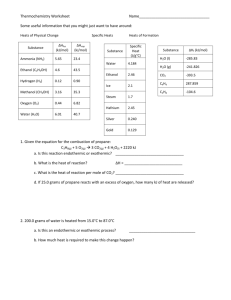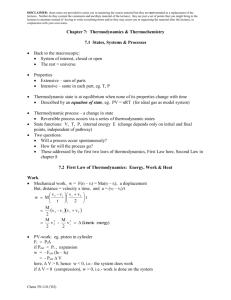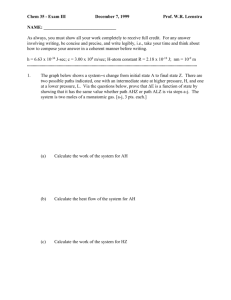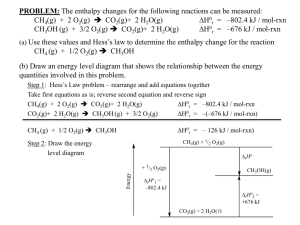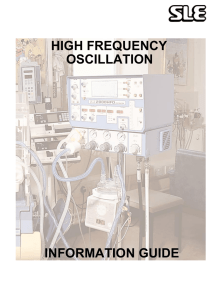H 2 (g) - SCH4U-SCHS
advertisement
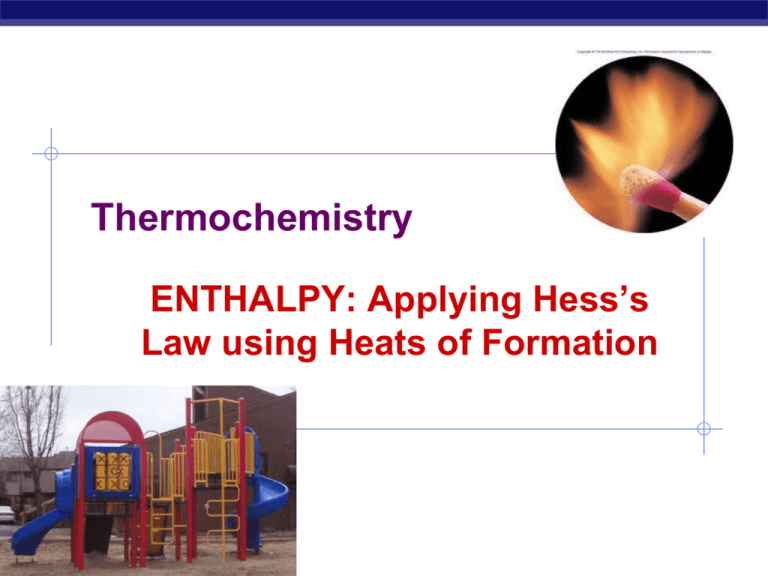
Thermochemistry
ENTHALPY: Applying Hess’s
Law using Heats of Formation
Review of Enthalpy Values
Depend on how the reaction is written and on
phases of reactants and products
H2(g) + 1/2 O2(g) --> H2O(g)
∆H˚ = -242 kJ
2 H2(g) + O2(g) --> 2 H2O(g)
∆H˚ = -484 kJ
H2O(g) ---> H2(g) + 1/2 O2(g)
∆H˚ = +242 kJ
H2(g) + 1/2 O2(g) --> H2O(liquid)
∆H˚ = -286 kJ
Standard Enthalpy of Formation
• If the heat content of a reaction cannot be
•
measured through calorimetry or Hess’s
Law, then a third method using tabulated
values can be used.
Standard Enthalpy of Formation (Hfo) of
a substance is defined as the
loss or gain of heat energy when one
mole of the substance is formed from its
elements in their standard states.
Standard Enthalpy of Formation
• At standard temperature and pressure (SATP),
elements exist in a preferred form, called the standard
conditions or state -101.3 KPa and 25 oC (298 K).
For example: Aluminum = Al (s)
hydrogen = H2(g) Carbon = C(graphite)
• If 1 mol of compound is formed from its constituent
elements (standard states), then the enthalpy change
for the reaction is called the enthalpy of formation,
Hof , measured in kJ/mol.
• The reference table in your textbook is on page 799-800,
appendix C4.
• Hfo = 0, for elements in their standard states.
You Try…
Write formation reactions for each:
1. H2SO4 (l)
2. NH4Cl (s)
**Remembera) Write one mole of product in the state that has been indicated.
b) The compounds are formed directly from their elements in their
standard states.
c) Balance the equation to produce one mole of product.**
You Try…
You want only one mole of the
product being formed.
Look up the ΔHf on the table
1. H2(g)+ S(s) + 2O2(g) H2SO4(l)
ΔH = -814 kJ/ mol
2. ½ N2(g) + 2H2(g) + ½ Cl2(g) NH4Cl
ΔH = -314.4 kJ/ mol
Standards Table
Solving Enthalpy using Hfo
There are two methods in solving for
ΔH using Hfo :
a longer method using Hess’s law and
a shorter method using a key equation.
Using Hess and heats of formation
Use heats of formation and Hess’s law to
determine the enthalpy of the following
target equation:
H2O(g) + C(graphite) --> H2(g) + CO(g)
Using Hess and heats of formation
(Rev) H2O(g) --> H2(g) + 1/2 O2(g) ∆Ho = +242 kJ
(same) C(s) + 1/2 O2(g) --> CO(g)
∆Ho = -111 kJ
-------------------------------------------------------------
H2O(g) + C(graphite) --> H2(g) + CO(g)
∆Honet = +131 kJ
To convert 1 mol of water to 1 mol each of H2
and CO requires 131 kJ of energy.
The “water gas” reaction is ENDOthermic.
Using Standard Enthalpies
Calculate ∆H of
reaction?
In general, when ALL
enthalpies of formation
are known:
∆Horxn = ∆Hfo (products) - ∆Hfo (reactants)
Remember that ∆ always = final – initial
Remember:
By definition, the enthalpy of formation of
an element in its standard state is zero.
Example, oxygen (O2) and chlorine (Cl2)
both have Hof of zero.
Sample Problem 1
Calculate ΔH for the following reaction
using standard molar heats of formation,
ΔH°f .
2NH3(g) + 3Cl2(g) → N2(g) + 6HCl(g)
ΔH = ?
H rxn nH f products mH f reactants
2NH3(g) + 3Cl2(g) → N2(g) + 6HCl(g)
ΔH°f for NH3(g) = -45.9 kJ/mol
ΔH°f for HCl(g) = -92.3 kJ/mol
ΔH°f for Cl2(g) and N2(g) is 0
ΔH = Σ nΔH°f(product) - Σ nΔH°f(reactant)
ΔH= (0 + 6(-92.3 kJ)) - (2(-45.9 kJ) + 0)
= (-553 kJ) - (-91.8 kJ)
= -461.2 kJ
Sample Problem 2
Calculate the heat of combustion of
methanol, i.e., ∆Horxn for
CH3OH(g) + 3/2 O2(g) --> CO2(g) + 2 H2O(g)
∆Horxn = ∆Hfo (prod) - ∆Hfo (react)
CH3OH(g) + 3/2 O2(g) --> CO2(g) + 2 H2O(g)
∆Horxn = ∆Hfo (prod) - ∆Hfo (react)
∆Horxn = ∆Hfo (CO2) + 2 ∆Hfo (H2O)
- {3/2 ∆Hfo (O2) + ∆Hfo (CH3OH)}
= (-393.5 kJ) + 2 (-241.8 kJ)
- {0 + (-201.5 kJ)}
∆Horxn = -675.6 kJ per mol of methanol


